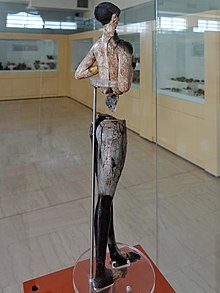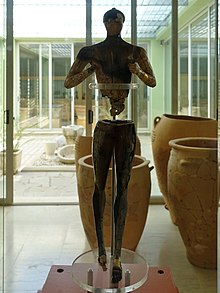310:
274:
298:
286:
98:
29:
473:
455:
Also: (Lapatin, Kenneth D. S., J. A. Macgillivray, J. M. Driessen, L. H. Sackett, C. V. Crowther, P. Harrison, S. A. Hemingway, R. B. Koehl, M. S. Moak, A. Moraitou, J. Musgrave, A. Nikakis, S. E. Thorne, and J. Weingarten. "The
Palaikastro Kouros: A Minoan Chryselephantine Statuette and Its Aegean
235:
The statue was found in several stages over a number of years: most of the torso in 1987, and the head in 1988. Unexpectedly, parts of the legs were then found in 1990, some thirty feet away from where the upper body parts had been. A thorough and careful water-sieving of six tons of soil from the
226:
that is thought to have taken place around 1450 BC, when the city of
Palaikastro was badly burned. Alternatively, it may have been destroyed by Minoan traditionalists, in a reaction to new Egyptian-influenced religious forms.
236:
site then produced hundreds of further fragments, including most of the feet, the eyes, and part of an ear. Piecing all these together took a further four years. Parts of a gold kilt and an ivory dagger
273:
218:
where Zeus grew up. The "young god" may have been a "vegetable god" who died in the winter and was reborn in the spring each year, perhaps associated with the
263:, it has been suggested that rubbing, lying, or sleeping on a baetyl could summon a vision of the god, an event which appears to be depicted on some gold
431:
MacGillivray J.A., Sackett L.H., Driessen J.M. et al., "The
Palaikastro Kouros, a Minoan Chryselephantine Statuette and its Aegean Bronze Age Context",
175:
with rock-crystal eyes and ivory details. Where the carved surface survives relatively well, the carving is extremely detailed, showing the veins and
527:
240:
were also found, but are not included in the reconstructed figure. Fragments of what is thought to have been a wooden base, painted with
497:
542:
477:
435:, BSA Studies, (1999). A book-length study by many authors, available on JSTOR, with each chapter treated as an article
179:
of the hands and feet. The face is completely missing, but the elaborate stone hairstyle, with "a shaved scalp and
206:, as a consort or son (or both?) of the main mother goddess. He has been regarded by some as a very early form of
144:
492:
222:. The figure has been burnt and apparently also deliberately smashed up, probably in the invasion of Crete by
537:
507:
522:
517:
443:
432:
248:
were also found. Possibly a "star-spangled" base represented the starry sky the god walked on.
309:
147:. Standing roughly 50 cm (19.5 in) tall, its large size by the standards of other figurines in
219:
211:
297:
285:
532:
8:
502:
202:
The figure presumably represents the "young god" who had appeared relatively recently in
156:
459:
279:
Map of "building 5" where parts of the statue were found at 4 locations, marked with *
171:
tooth covered with gold foil, but the hair part of the head is carved from gray-green
180:
118:
512:
396:
260:
223:
203:
237:
215:
192:
110:
486:
241:
183:-like crest", survives. The position of the arms can be parallelled in some
85:
67:
439:
252:
172:
168:
195:
overlooking the town. The ivory pieces were held together with olivewood
264:
214:. Palaikastro is very close to one of the main traditional sites of the
136:
63:
447:
404:
97:
28:
184:
152:
148:
140:
128:
245:
442:. “The Palaikastro Kouros: the Cretan God as a Young Man”, p. 166,
255:
boulder was excavated very close to the kouros; perhaps it was its
188:
456:
Bronze Age
Context." American Journal of Archaeology 106.2 (2002))
167:
The majority of its body (torso, legs, arms, and feet) is made of
16:
Bronze-age statue of a male found at
Roussolakkos in east Crete.
472:
256:
176:
123:
89:
71:
196:
132:
81:
151:, and the value of its materials may indicate that it was a
207:
462:
at the
Odysseus portal of the Hellenic Ministry of Culture
267:rings, where the stones are large oval boulders.
139:1B period in the mid-15th century BC, during the
484:
127:) excavated in stages in the modern-day town of
399:(2004), "The Character of Minoan Epiphanies",
438:"Chapter 14": MacGillivray, Alexander, and
27:
155:for worship, the only one known from the
96:
426:The Metropolitan Museum of Art Bulletin
485:
446:Studies, vol. 6, 2000, pp. 165–169.
528:Archaeological discoveries in Crete
428:, Spring 2012 Volume LXIX, Number 4
13:
14:
554:
466:
471:
308:
296:
284:
272:
498:1987 archaeological discoveries
145:Archaeological Museum of Siteia
390:
381:
372:
363:
354:
345:
336:
327:
162:
143:. It is now on display in the
33:Palaikastro Kouros from behind
1:
414:
230:
210:, the main god in much later
50:
422:Art of the Aegean Bronze Age
403:, vol. 29, 2004, pp. 32–39,
7:
543:Sculptures of men in Greece
135:. It has been dated to the
121:statuette of a male youth (
10:
559:
401:Illinois Classical Studies
114:
77:
57:
46:
38:
26:
21:
444:British School at Athens
433:British School at Athens
407:. Accessed 18 Feb. 2021.
320:
450:. Accessed 22 Feb. 2021
131:on the Greek island of
115:Κούρος του Παλαίκαστρου
460:The Palaikastro Kouros
220:constellation of Orion
212:Ancient Greek religion
102:
493:15th-century BC works
480:at Wikimedia Commons
259:or sacred stone. In
100:
342:Chapter 14, 167-169
244:and decorated with
157:Minoan civilization
538:Sculptures of Zeus
508:Ivory works of art
478:Palaikastro Kouros
107:Palaikastro Kouros
103:
101:Palaikastro Kouros
22:Palaikastro Kouros
523:Statues in Greece
476:Media related to
420:Hemingway, Seán,
95:
94:
550:
475:
408:
397:Marinatos, Nanno
394:
388:
385:
379:
376:
370:
367:
361:
358:
352:
349:
343:
340:
334:
331:
312:
300:
288:
276:
119:chryselephantine
116:
78:Present location
52:
31:
19:
18:
558:
557:
553:
552:
551:
549:
548:
547:
518:Minoan religion
483:
482:
469:
417:
412:
411:
395:
391:
387:Chapter 14, 166
386:
382:
378:Chapter 14, 166
377:
373:
368:
364:
360:Chapter 14, 169
359:
355:
350:
346:
341:
337:
332:
328:
323:
316:
313:
304:
301:
292:
289:
280:
277:
261:Minoan religion
233:
224:Mycenean Greece
204:Minoan religion
187:figurines from
165:
62:
34:
17:
12:
11:
5:
556:
546:
545:
540:
535:
530:
525:
520:
515:
510:
505:
500:
495:
468:
467:External links
465:
464:
463:
457:
453:
452:
451:
429:
416:
413:
410:
409:
389:
380:
371:
362:
353:
344:
335:
325:
324:
322:
319:
318:
317:
314:
307:
305:
302:
295:
293:
290:
283:
281:
278:
271:
232:
229:
216:Dicktaian Cave
193:peak sanctuary
164:
161:
93:
92:
79:
75:
74:
59:
55:
54:
48:
44:
43:
40:
36:
35:
32:
24:
23:
15:
9:
6:
4:
3:
2:
555:
544:
541:
539:
536:
534:
531:
529:
526:
524:
521:
519:
516:
514:
511:
509:
506:
504:
501:
499:
496:
494:
491:
490:
488:
481:
479:
474:
461:
458:
454:
449:
445:
441:
437:
436:
434:
430:
427:
423:
419:
418:
406:
402:
398:
393:
384:
375:
369:Hemingway, 31
366:
357:
351:Hemingway, 31
348:
339:
333:Hemingway, 31
330:
326:
311:
306:
303:Another angle
299:
294:
291:Another angle
287:
282:
275:
270:
269:
268:
266:
262:
258:
254:
249:
247:
243:
242:Egyptian blue
239:
228:
225:
221:
217:
213:
209:
205:
200:
198:
194:
190:
186:
182:
178:
174:
170:
160:
158:
154:
150:
146:
142:
138:
134:
130:
126:
125:
120:
112:
108:
99:
91:
87:
83:
80:
76:
73:
69:
65:
60:
56:
49:
45:
41:
37:
30:
25:
20:
470:
440:Hugh Sackett
425:
421:
400:
392:
383:
374:
365:
356:
347:
338:
329:
253:serpentinite
250:
234:
201:
173:serpentinite
169:hippopotamus
166:
122:
106:
104:
533:Cult images
265:Minoan seal
163:Description
137:Late Minoan
129:Palaikastro
64:Palaikastro
503:Minoan art
487:Categories
415:References
231:Excavation
185:terracotta
153:cult image
149:Minoan art
141:Bronze Age
58:Discovered
246:gold leaf
251:A small
189:Petsofas
177:tendons
117:) is a
53:1450 BC
47:Created
513:Kouroi
315:Detail
257:baetyl
238:pommel
197:dowels
181:Mohawk
124:kouros
90:Greece
72:Greece
39:Height
448:JSTOR
405:JSTOR
321:Notes
133:Crete
111:Greek
86:Crete
82:Sitia
68:Crete
42:50 cm
208:Zeus
191:, a
159:.
105:The
61:1987
199:.
489::
424:,
113::
88:,
84:,
70:,
66:,
51:c.
109:(
Text is available under the Creative Commons Attribution-ShareAlike License. Additional terms may apply.

